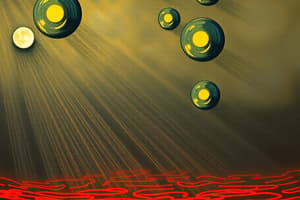Podcast
Questions and Answers
What is conduction most effective in?
What is conduction most effective in?
- Gases
- Liquids
- Solids (correct)
- Plasmas
What does convection involve?
What does convection involve?
- Movement of charges in a solid
- Density differences in gases or liquids (correct)
- Radiation of heat through vacuum
- Transfer of heat through direct contact
Which statement best describes the Coriolis Effect?
Which statement best describes the Coriolis Effect?
- It affects the rotation of the Earth.
- It deflects moving objects in a rotating system. (correct)
- It causes objects to move faster as they approach the equator.
- It is responsible for magnetic field generation.
What is the primary outcome of denitrification?
What is the primary outcome of denitrification?
What characterizes the exosphere?
What characterizes the exosphere?
What does humidity measure?
What does humidity measure?
In which layer of the atmosphere is the ionosphere found?
In which layer of the atmosphere is the ionosphere found?
What is the latitude at the North Pole?
What is the latitude at the North Pole?
What defines acid rain?
What defines acid rain?
Which process involves the transformation of organic nitrogen into ammonia?
Which process involves the transformation of organic nitrogen into ammonia?
What is the primary role of assimilation in the nitrogen cycle?
What is the primary role of assimilation in the nitrogen cycle?
What is a defining characteristic of combustion?
What is a defining characteristic of combustion?
Which group of organisms relies on assimilation for nitrogen?
Which group of organisms relies on assimilation for nitrogen?
What are the common pollutants that lead to the formation of acid rain?
What are the common pollutants that lead to the formation of acid rain?
In which scenario does combustion typically occur?
In which scenario does combustion typically occur?
What outcome results from ammonia being assimilated by organisms?
What outcome results from ammonia being assimilated by organisms?
Which type of ultraviolet light is most effectively absorbed by ozone?
Which type of ultraviolet light is most effectively absorbed by ozone?
What is one major source of sulfur dioxide (SO2) contributing to acid rain?
What is one major source of sulfur dioxide (SO2) contributing to acid rain?
Which of the following is NOT a form of acid deposition?
Which of the following is NOT a form of acid deposition?
What primarily causes the formation of nitric acid in the atmosphere?
What primarily causes the formation of nitric acid in the atmosphere?
How does dry deposition occur?
How does dry deposition occur?
Which activity is a major contributor to nitrogen oxides (NOX) emissions?
Which activity is a major contributor to nitrogen oxides (NOX) emissions?
What potential damage is caused by UV-B and UV-C radiation?
What potential damage is caused by UV-B and UV-C radiation?
Which of these statements about acid rain is true?
Which of these statements about acid rain is true?
What compounds are primarily responsible for the deterioration of the ozone layer?
What compounds are primarily responsible for the deterioration of the ozone layer?
What is the main culprit behind the breakdown of ozone molecules?
What is the main culprit behind the breakdown of ozone molecules?
What is one harmful effect of increased ultraviolet B rays reaching Earth due to ozone depletion?
What is one harmful effect of increased ultraviolet B rays reaching Earth due to ozone depletion?
Since when has the ozone layer, particularly above Antarctica, been impacted by pollution?
Since when has the ozone layer, particularly above Antarctica, been impacted by pollution?
Which region is noted for emitting approximately 90 percent of the CFCs currently in the atmosphere?
Which region is noted for emitting approximately 90 percent of the CFCs currently in the atmosphere?
What occurs to CFCs when they reach the upper atmosphere?
What occurs to CFCs when they reach the upper atmosphere?
How do chlorine atoms impact ozone molecules?
How do chlorine atoms impact ozone molecules?
What is the main process by which atmospheric nitrogen (N2) is converted into a biologically available form?
What is the main process by which atmospheric nitrogen (N2) is converted into a biologically available form?
Measuring acid rain involves which type of precipitation?
Measuring acid rain involves which type of precipitation?
In plants, which of the following correctly describes the assimilation process?
In plants, which of the following correctly describes the assimilation process?
Which process is responsible for converting ammonia into nitrite and then nitrate?
Which process is responsible for converting ammonia into nitrite and then nitrate?
Denitrification plays a crucial role in the nitrogen cycle by achieving what?
Denitrification plays a crucial role in the nitrogen cycle by achieving what?
What role do Rhizobia bacteria play in the nitrogen cycle?
What role do Rhizobia bacteria play in the nitrogen cycle?
Which statement about ammonification is accurate?
Which statement about ammonification is accurate?
What primary function do anammox bacteria serve in the nitrogen cycle?
What primary function do anammox bacteria serve in the nitrogen cycle?
Which organisms typically participate in nitrogen fixation apart from prokaryotes?
Which organisms typically participate in nitrogen fixation apart from prokaryotes?
Flashcards are hidden until you start studying
Study Notes
Heat Transfer Mechanisms
- Conduction: Transfer of heat through matter via particle interaction; most efficient in solids.
- Convection: Heat transfer in gases and liquids driven by density differences.
Atmospheric Concepts
- Coriolis Effect: Causes moving masses in a rotating system to deflect; right in the northern hemisphere, left in the southern; significant in cyclonic weather formation.
- Denitrification: Converts nitrate into nitrogen gas, reducing bioavailable nitrogen in the atmosphere.
- Exosphere: A thin outer layer enveloping planets or moons, where molecules are held by gravity but do not behave like gas due to low density.
- Humidity: Measurement of water vapor present in the atmosphere at any given location on Earth.
- Ionosphere: Atmospheric layer rich in ions and free electrons, capable of reflecting radio waves, located 50 to 600 miles above Earth.
Latitude
- Defined as an angle from 0° at the Equator to 90° at the poles, impacting climate and weather patterns.
Acid Rain
- Precipitation with pH lower than 5.6, resulting from pollutants like sulfur dioxide and nitrogen oxides.
- Major contributors: burning fossil fuels, vehicle emissions, industrial processes.
- Forms of Acid Deposition:
- Dry deposition: Acidic gases and particles fall to Earth.
- Wet deposition: Acids fall as rain, snow, or fog.
Nitrogen Cycle Processes
- Nitrogen Fixation: Transforming atmospheric N2 into biologically usable forms; mainly conducted by prokaryotes, with some abiotic contributions from lightning.
- Assimilation: Plant absorption of inorganic nitrogen like nitrate or ammonium from the soil for amino acid synthesis; symbiotic relationships with rhizobia aid in ammonium absorption.
- Nitrification: Converts ammonia to nitrite and then nitrate; involves anammox bacteria oxidizing ammonia to produce nitrogen gas.
- Ammonification: Releases inorganic nitrogen as ammonia during the decomposition of organic matter by fungi and prokaryotes.
Ozone and Ultraviolet Radiation
- Ozone layer reduces harmful UV radiation; absorbs 95-99.9% of UV light.
- Acid rain impacts ecosystems, and deteriorating ozone layer leads to increased UV-B exposure.
- Ozone Depletion: Caused by pollutants containing bromine and chlorine, primarily from CFCs, which break down ozone in the stratosphere.
- Historically, industrialized nations contributed significantly to CFC emissions.
Self-Help Resources
- Further understanding can be gained from readings in atmospheric chemistry and physics.
Studying That Suits You
Use AI to generate personalized quizzes and flashcards to suit your learning preferences.




